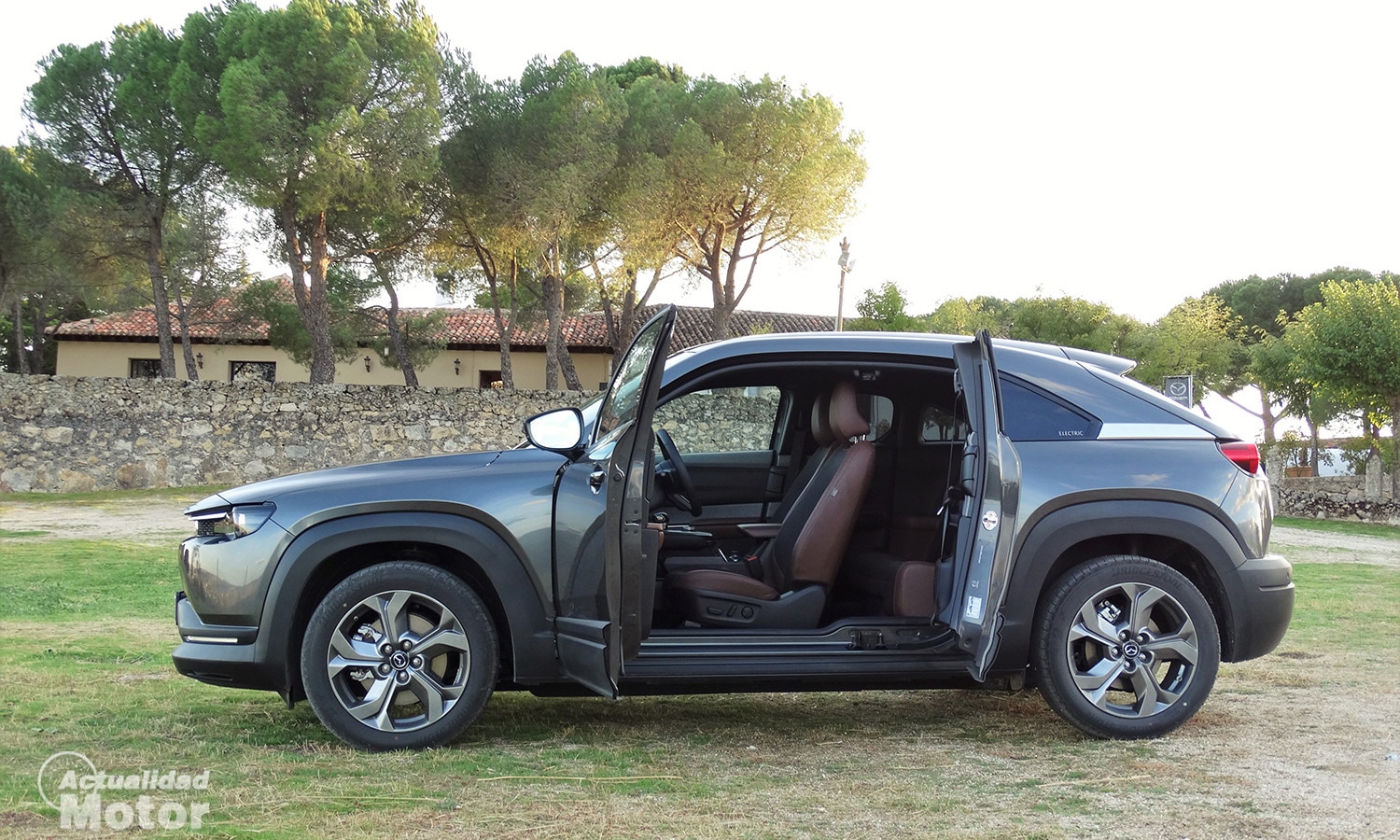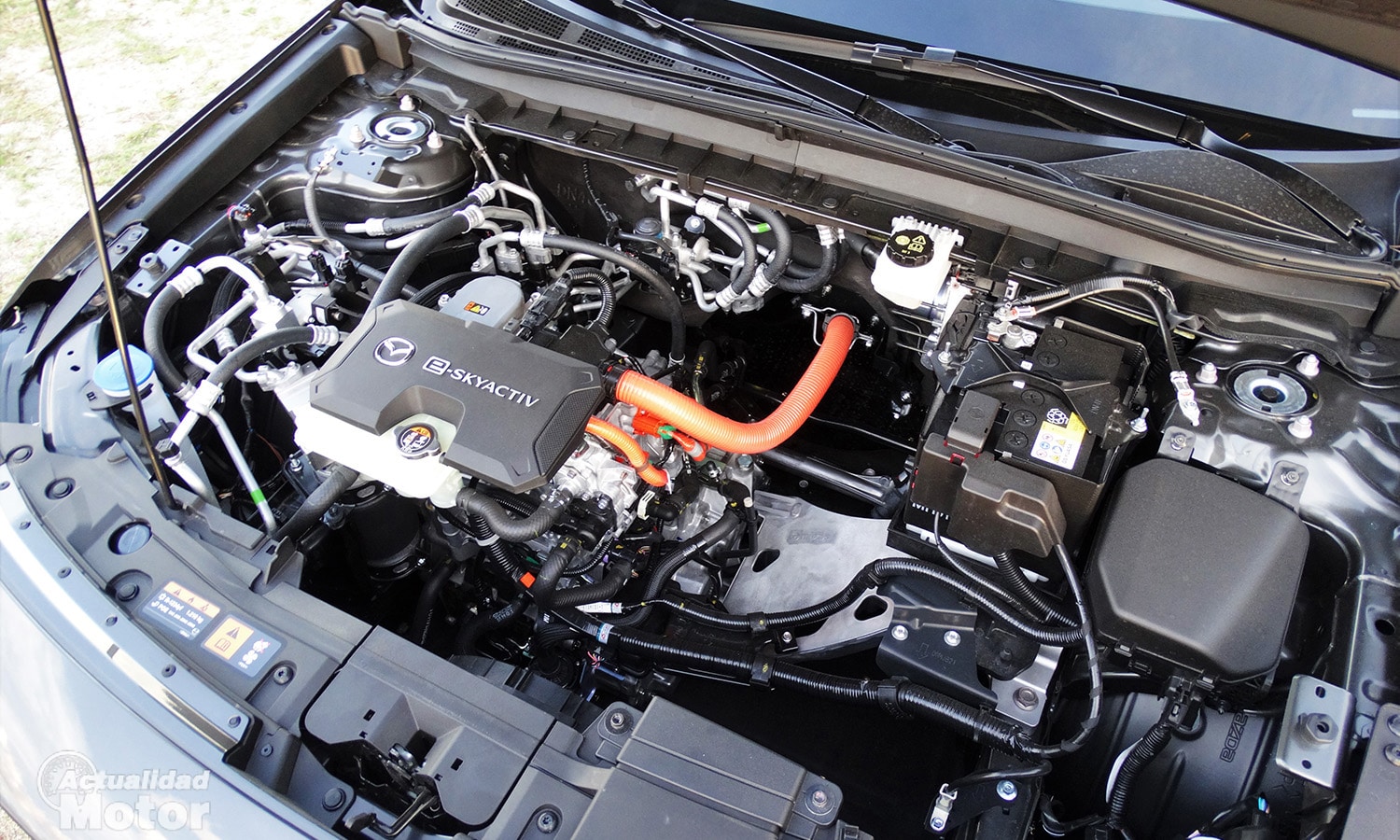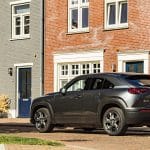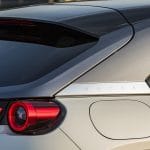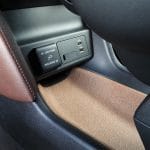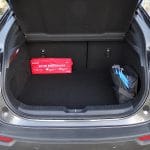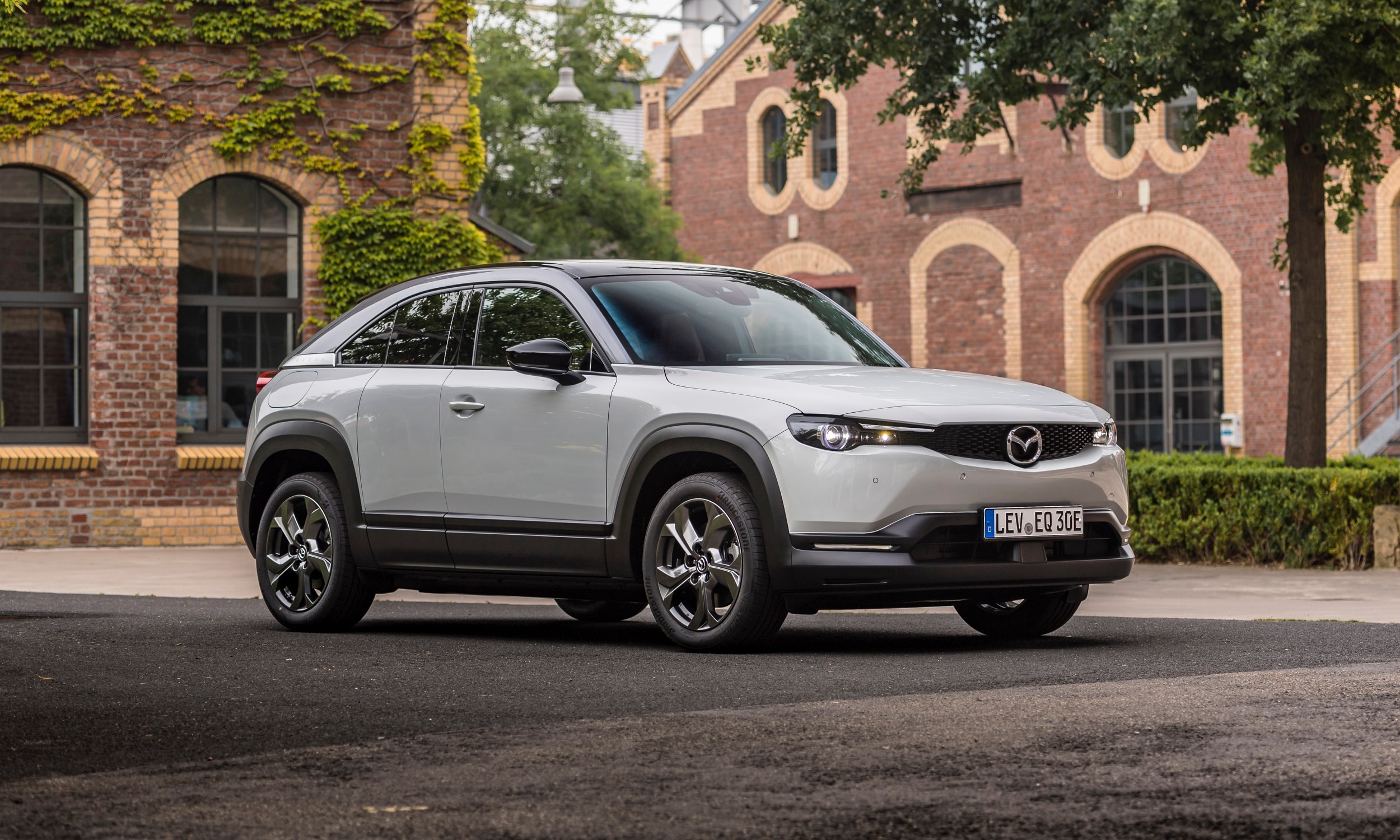
Mazda has already presented its first production electric car, the Mazda MX-30. And you know what the best of all is? We have already been able to test it! A few days ago we were at the national presentation of the new electric urban crossover from the Japanese company. It debuts with about 200 km of real autonomy and 145 CV.
It will not be a high-volume car, since its approach is different from that of the vast majority of Power Plants. Also, it's not too cheap either. It is mainly focused on a client premium and with a good checking account who is looking for a striking and practical model for his urban trips.
As Mazda told us, the MX-30 is one of the most important launches in its history. The regular customer already has at least one other vehicle with which to make long-distance journeys. However, this product seeks to enter those people of certain purchasing power who travel about 50 kilometers a day and who reside in large cities or in the surrounding area.
Different, but Kodo: This is the Mazda MX-30
The Hiroshima brand wanted to give a different touch to this electric crossover, but also keep the main idea of Kodo design. In this way, we have before us a new model, but easily recognizable as a Mazda.
In fact, keep in mind that it takes the same platform as the Mazda CX-30. Moreover, their external dimensions are very similar. It measures 4.395 mm long, 1.795 wide, 1.570 high and has a wheelbase of 2.653 mm.
What stands out the most about the MX-30 on an aesthetic level is the side view. Notice that it takes on an aspect with certain coupé airs. So much so that the rear pillar strikes me as somewhat excessive, significantly reducing the glass surface of the rear doors. But since we have talked about the pillar, this model does not have a central pillar and resort to back doors”free style”, traditionally known as “suicide doors”.
Logically, the brand has reinforced the chassis structure to compensate for that lost rigidity due to the absence of the central pillar. So much so that the chassis is 30% stiffer than the Mazda CX-30. By the way, we can find a two-tone roof, and this part can be in the same color as the bodywork, in gray or black.
Ecological materials for the interior

If we open the front doors and enter the passenger compartment, the interior never ceases to amaze us. Logically, the instrument panel it is specific to this model due to its condition as an electric vehicle. It has a classic design, integrating a central digital screen for the different driving information. The steering wheel is inherited from the rest of the brand's models, such as the CX-30 or Mazda3.
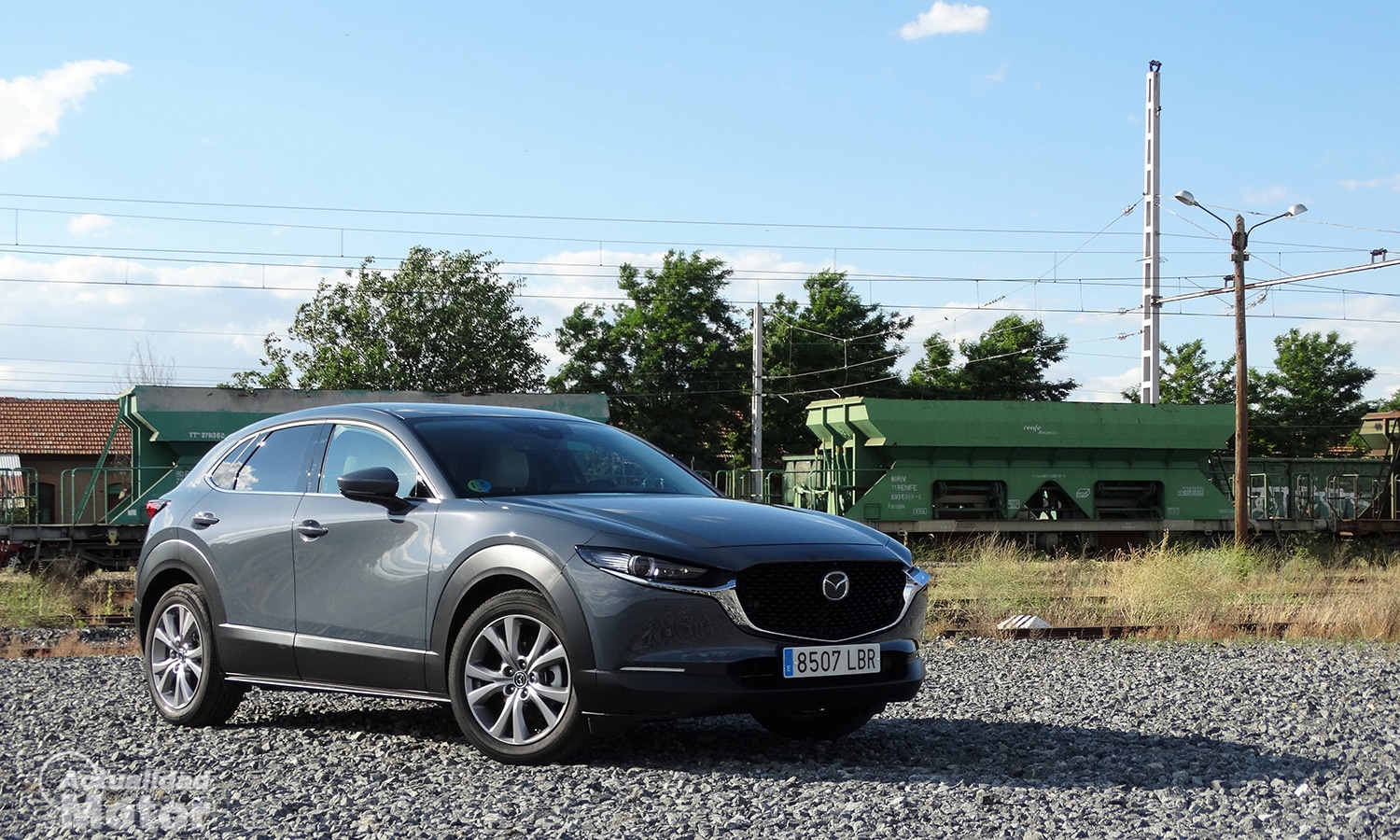
the top of the dashboard is very clean, appearing a screen of 8,8 inch infotainment which is controlled from a control in the center console. Further down we have a new screen for the climate control. It is touch and 7 inches, but on the sides it has several physical buttons to vary the temperature of the climate or the speed of the fan.
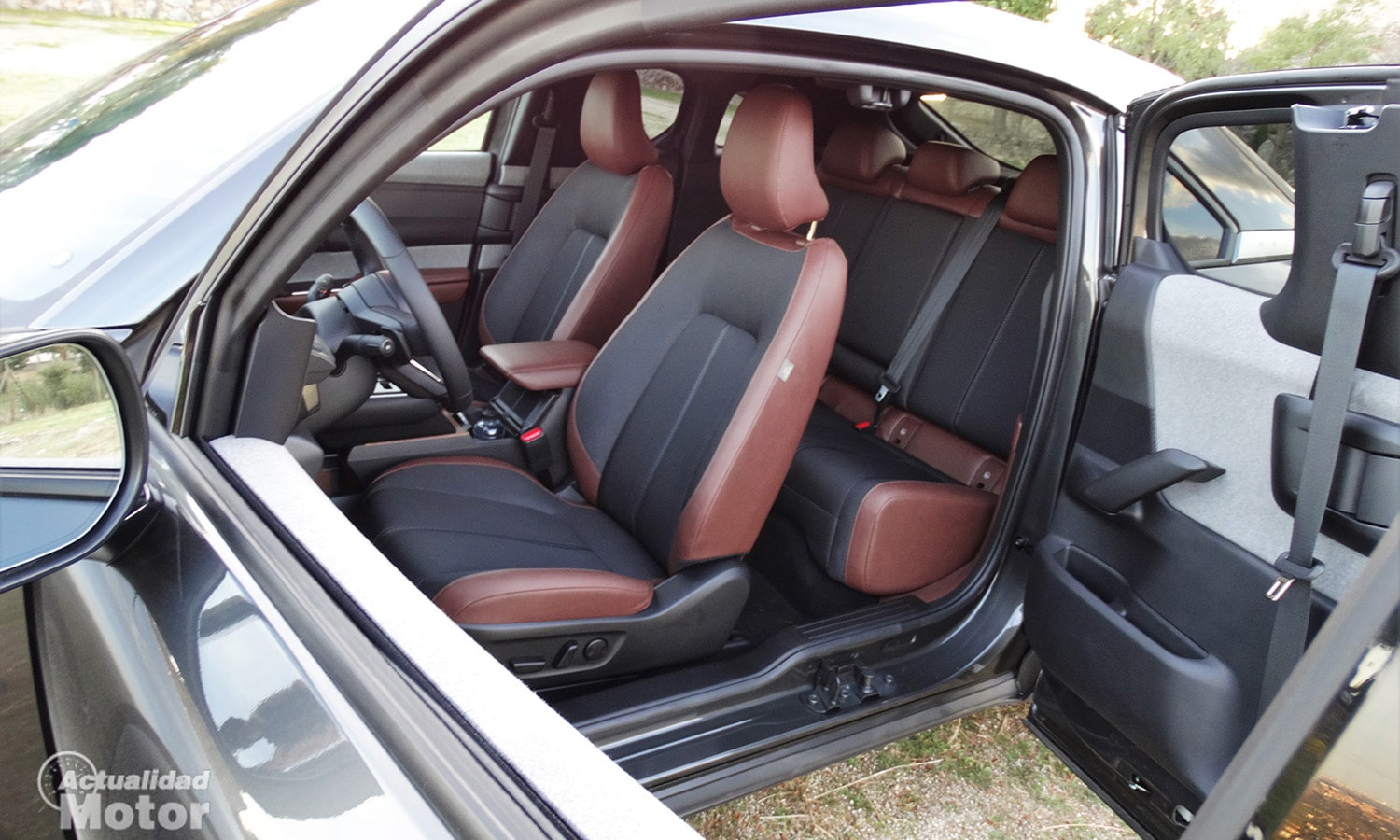
On the other hand we have two well differentiated interior designs. the finish Modern has light tones combining gray and white on the seats, while in the denomination Vintage they are darker tones, with parts in black and brown.
To all this we must add that Mazda uses recycled sustainable materials such as synthetic leather, recycled PET plastic bottles and cork. The touch of the different parts is, to say the least, curious, especially the cork areas.
Correct and sufficient space for your intentions
Regarding the interior space, in the front seats no problem for people of virtually any size in all directions. In addition, in some finishes it has electrically adjustable seats and a memory function, which always comes in handy when the car is shared with more members of the family.
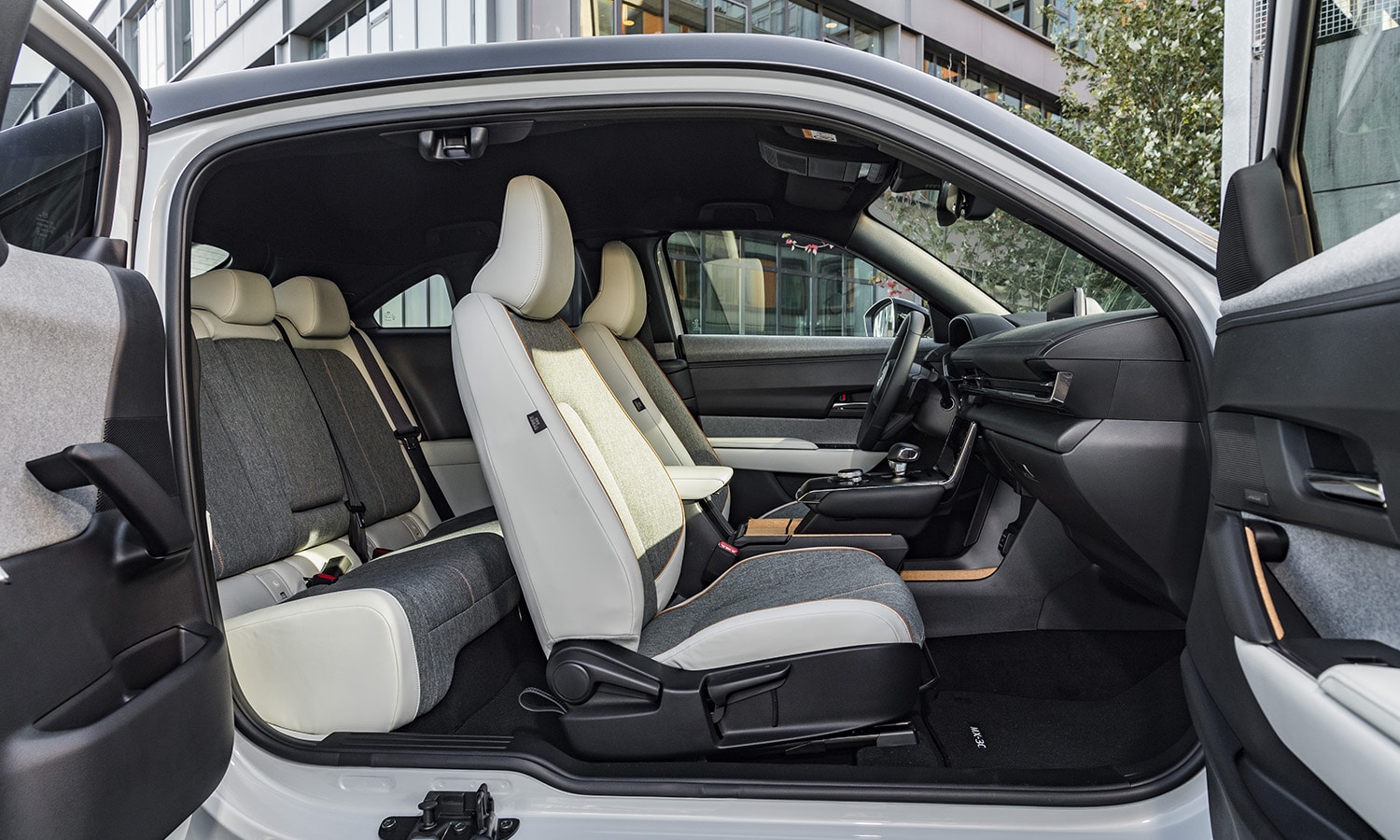
To access the rear seats You have to open the front doors and, later, the rear ones, which, as we have already said, open in reverse of what we are used to. The access that remains is not wide, but we can comfortably move the front seat forward to facilitate it.
Once here behind, and with the front seat adjusted to my 1,76 height, the position is a bit different than usual. It has given me the feeling of going with the back more vertical than usual.
Despite this, I have not come to touch the ceiling with my head, having a few centimeters of margin. The knee space is somewhat fairer, but acceptable enough. Of course, since the window is so small, it gives the impression of being less spacious than it really is.
This car is approved for five occupants, although I am afraid that the central square is not comfortable enough for three adults to sit in these three rear seats. In any case, nothing out of the ordinary in most cars on the market.
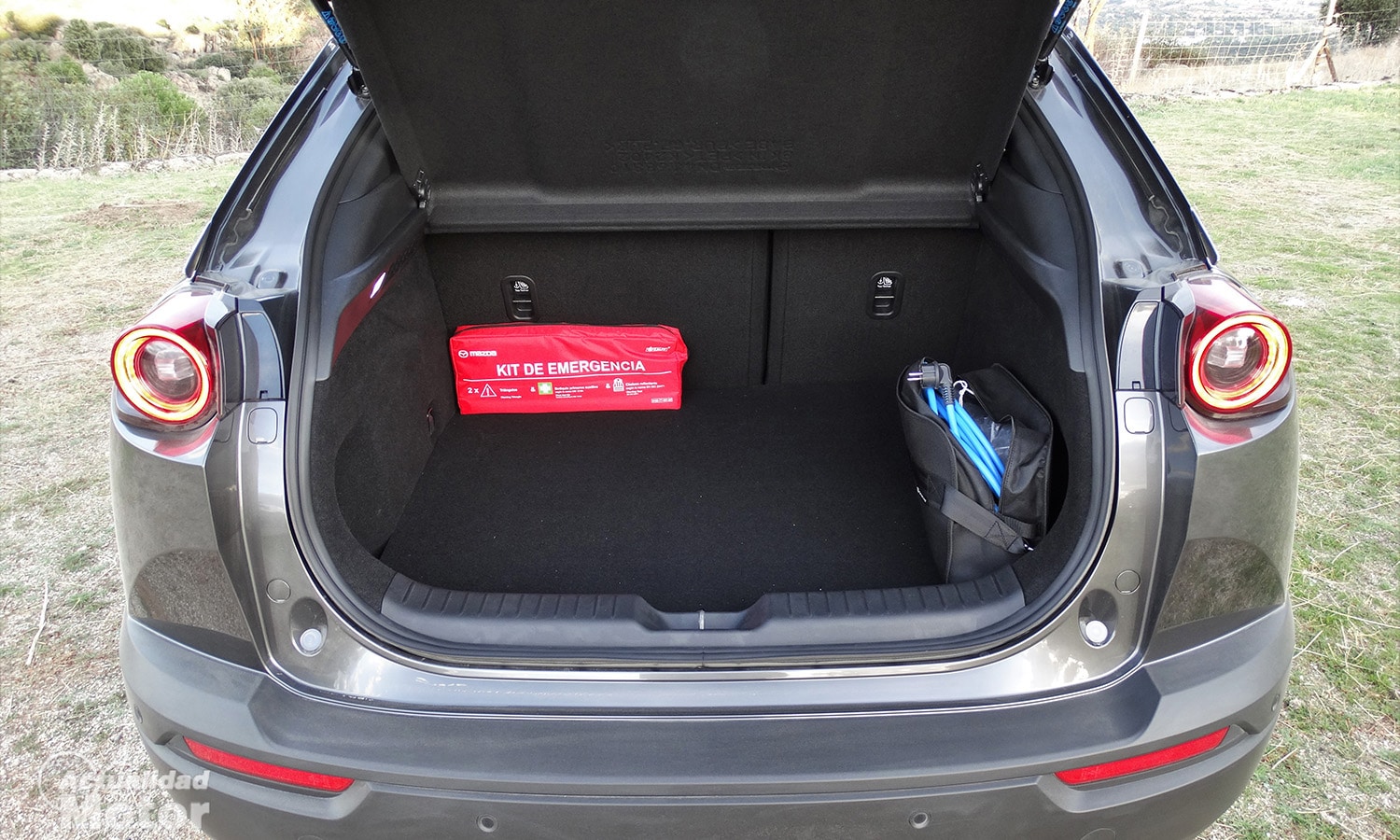
Meanwhile the trunk cubic 366 liters. It is a correct capacity and more or less according to the total length of the vehicle. In addition, I consider that it is more than enough considering that it is not a car oriented to travel. By the way, with the Bose audio equipment the space is reduced by 25 liters due to the subwoofer.
This is the mechanics of the Mazda MX-30
Now let us quote the main data of the electric propulsion system. We start with the battery, which is 35,5 kWh and composed of lithium ions. Mazda says it doesn't see fit to equip a larger battery because most European drivers don't do more than 50 kilometers a day.
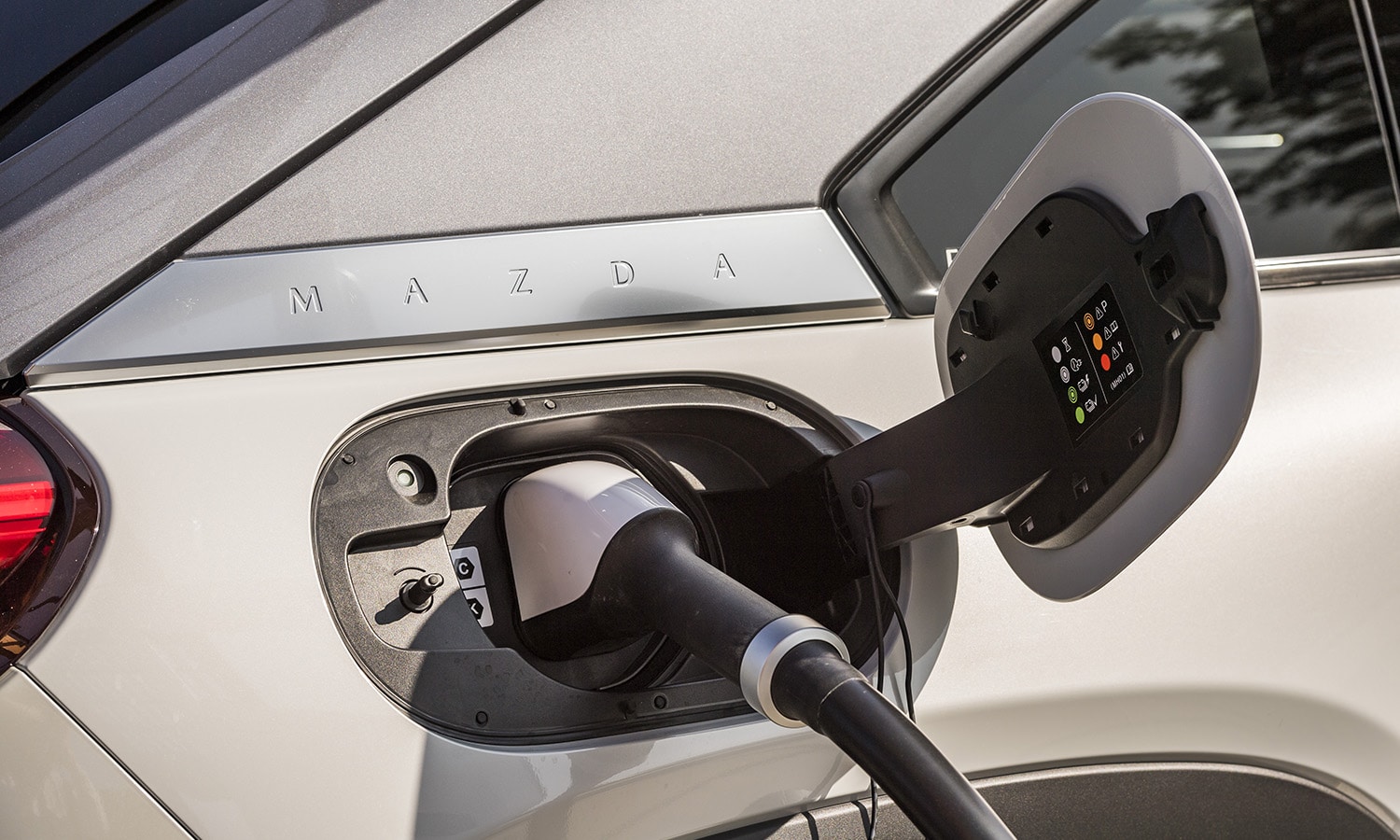
A larger battery means more ballast - thus increasing energy consumption while driving - and, of course, more pollution during its production. The weight of this is 310 kilos.
El electric motor it is located in the front train and is cooled by water. develop 145 hp and 271 Nm of torque. Top speed is limited to 140 km/h while it can do 0-100 km/h in 9,7 seconds. For its part, the combined consumption in WLTP is 19 kWh/100 km, obtaining a approved autonomy of 200 km. In urban cycle autonomy is 265 km.
As additional data, the maximum load accepted by the battery is 50 kW. On the other hand, and as a detail of great importance, the battery is guaranteed for 8 years with at least 70% of its performance.
At the wheel: Enough thrust and good touch
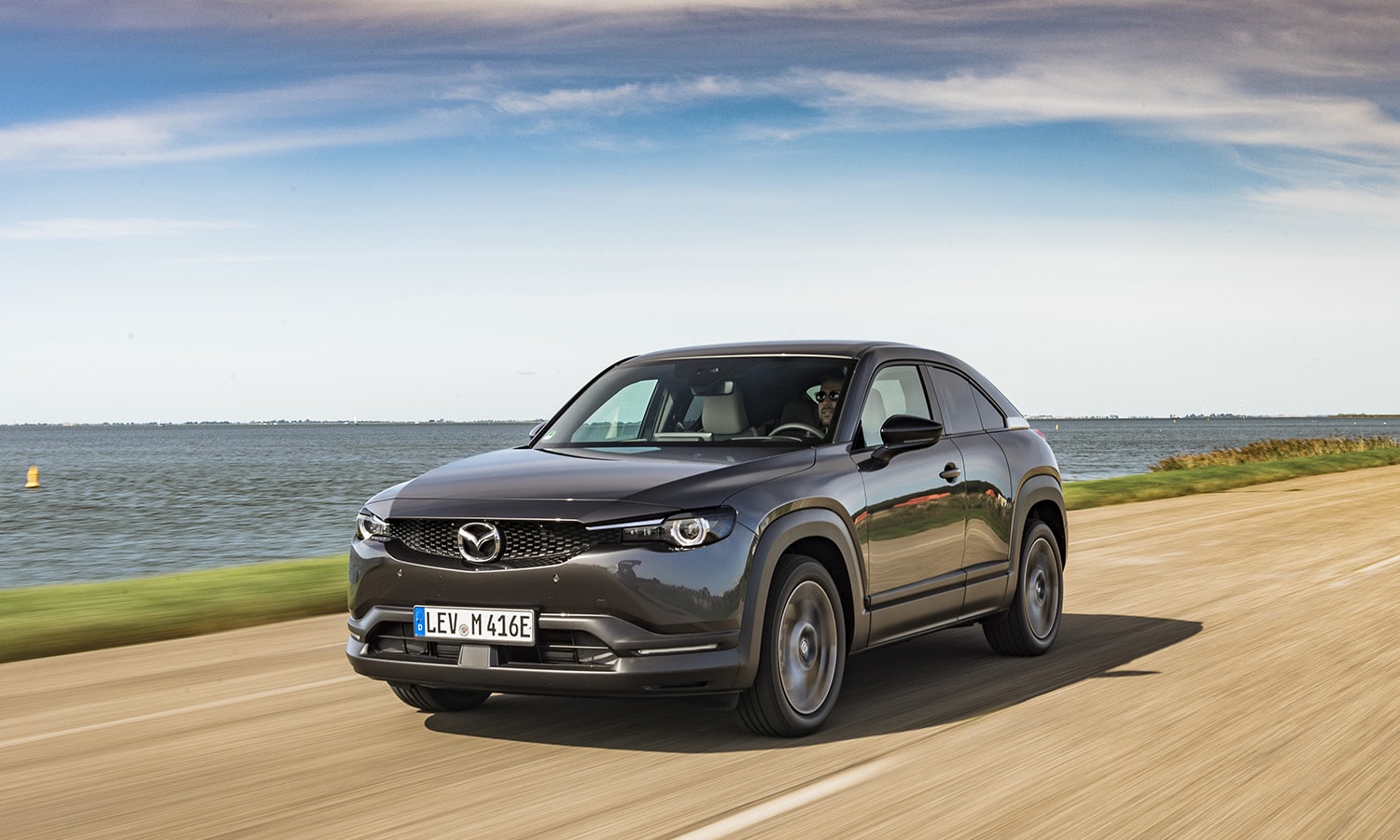
During this presentation we were able to travel almost 100 kilometers with the Mazda MX-30. It is not a long test, but it is enough to extract some first driving impressions. As in any electric vehicle, silence stands out in the cabin.
Once we leave the parking lot, where it demonstrates a great turning capacity, the MX-30 shows a different behavior from that of most electric cars. First because it is much more soft when it comes to delivering its energy. You already know that electric thrusters can give all their torque instantly, which translates into an energetic and, in a way, abrupt kick.
Mazda has preferred to soften that first throttle stroke, avoiding possible tire slippage. This produces smoother acceleration, lengthening the life of tires and transmission components. In any case, if we accelerate fully, it picks up speed quickly enough.
On the other hand, in order for us to have a greater perception inside, they have developed what they call Mazda SoundConcept. It is a very slight sound that emanates from the speakers during acceleration. When I heard about this technology, I thought it would be of little use. The truth is that it is not something fundamental, but I admit that I think it is a good idea.

As for the driving itself, it shows quite agile for urban use. Of course, despite this, we must take into account that they are 4,4 meters long. That is, it is not as small as other electric type Peugeot e-208 o Renault Zoe, which measure approximately 4 meters. Rear visibility isn't a positive on the Mazda either, especially in the rear three-quarters.
The programmed route made us go through some curved areas. An electric is not usually synonymous with having fun, but it is true that the Mazda MX-30 invites more fun than other models with a similar approach. Steering is quick and precise - though not as informative as in a Mazda3 - the low weight and center of gravity they help it turn nimbly and the 270Nm of torque and 145PS get it out of slow corners quickly.
That yes, although the test has not been too long and I have to verify it more carefully, it has given me the feeling that the front end is a bit dry when we go through rough potholes. Only in those moments, because in softer bumps it has seemed to me that it absorbs correctly. The rear axle, which has a torsion bar, is very well tuned.
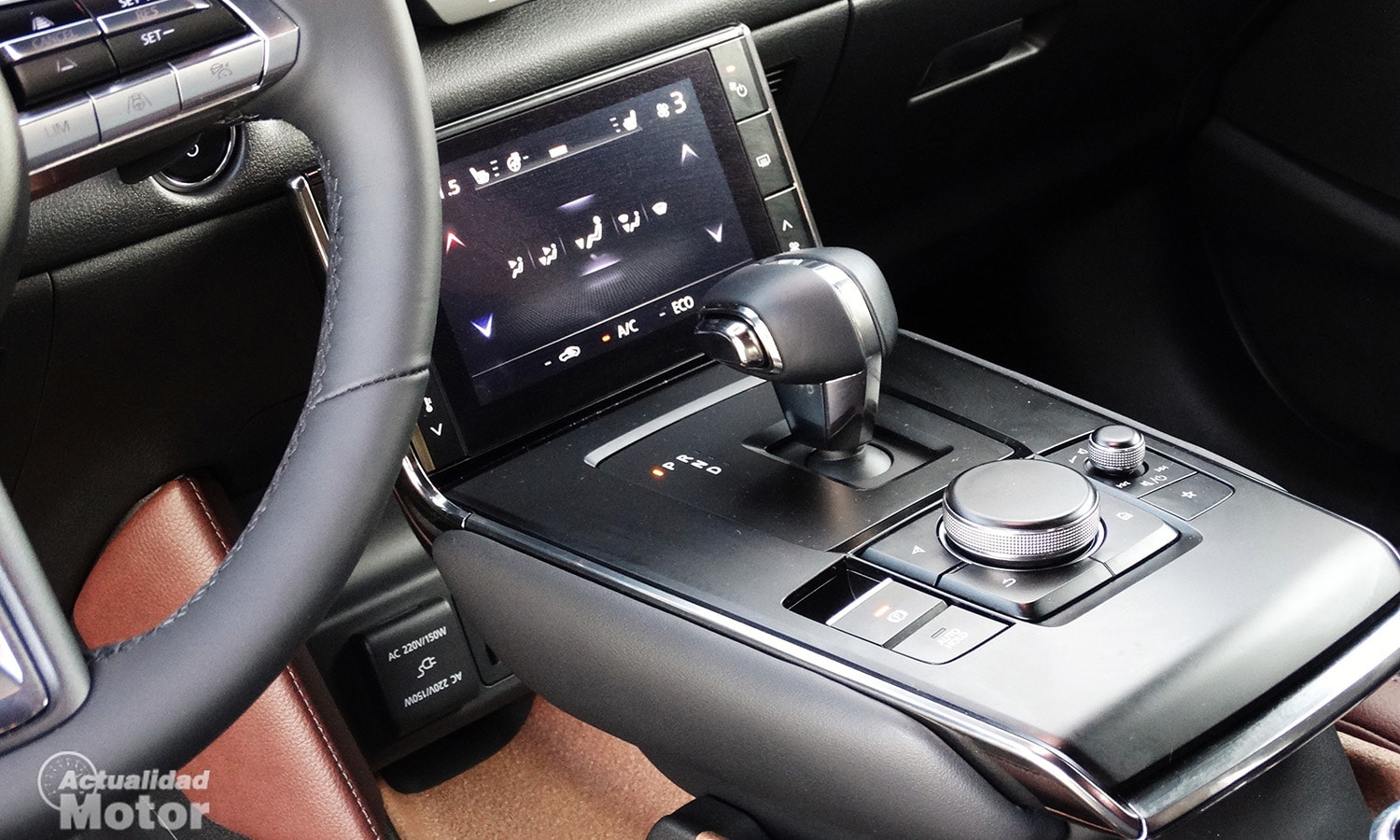
An interesting detail is that we have paddles behind the wheel. These cams are used to increase or decrease retention of the electric motor when we stop accelerating, something very practical both when going down a mountain pass and when driving on fast roads. We have five levels. With the left cam of the steering wheel we increase that retention, while with the right we decrease it. We can practically play with them without having to activate the service brake during normal braking.
And speaking of brakes, unlike other electric and hybrid models, the MX-30 has very well achieved the touch of the pedal. In other models it is difficult to measure the braking well due to the change from regenerative braking to traditional brakes. With him I have felt very comfortable in that sense, going completely unnoticed, which is always very positive.
Depending on the speed at which we go, the engine response it is more energetic or lazy, something that is noticeable in all electric cars. It is noted that it loses capabilities the higher the speed. But, after all, this also happens in heat engines. The fact is that we can easily overtake if the speed is low, but from 80 or 90 km/h we have to make sure more as the response begins to be slower.
We were also able to travel about 20 kilometers by dual carriageway. Of course, the Mazda MX-30 maintains a pleasant feeling of poise at 120 km/h and is more than capable of maintaining that speed on slopes. Of course, as I said before, although they are not bad, the recoveries are not as fast as in a diesel or gasoline model of similar power.
Finally, let's talk about consumptions. It is true that it is a presentation and that in many moments I practiced aggressive driving with the throttle to check the response of the engine. Despite this, when I started the test the trip computer marked 190 kilometers of autonomy. After the 95 kilometers of testing, in the table I saw reflected a consumption of 16,9 kWh / 100 km and a remaining autonomy of 90 kilometers. So, it is easy to reach those 200 approved kilometers in mixed cycle, and even surpass them.
Conclusions
The Mazda MX-30 has clear ideas. It is a car whose price is not cheap and has little autonomy despite its 4,40 meters in length. Its size is not compensated with its autonomy within the normality of electric searches. The market, in general, is looking for cheap electric cars with enough autonomy, or expensive and powerful electric cars with a long range. This Mazda does not fall into either of those two types, but It goes to a very specific audience and with a certain logic.
In addition, it is already very well equipped as standard and has a differentiated design but 100% Mazda. The brand estimates that in our country they will sell around 350 units in this 2020 if the health crisis allows it. By the way, during this 2020, due to an agreement with Iberdrola, they give you a Wallbox, which is not exactly bad...
On the other hand, during the next year 2021 the extended autonomy version will arrive. It will use a small rotary motor to be able to considerably increase autonomy by recharging the battery. Of course, of course, at the cost of burning gasoline.
Equipment Mazda MX-30
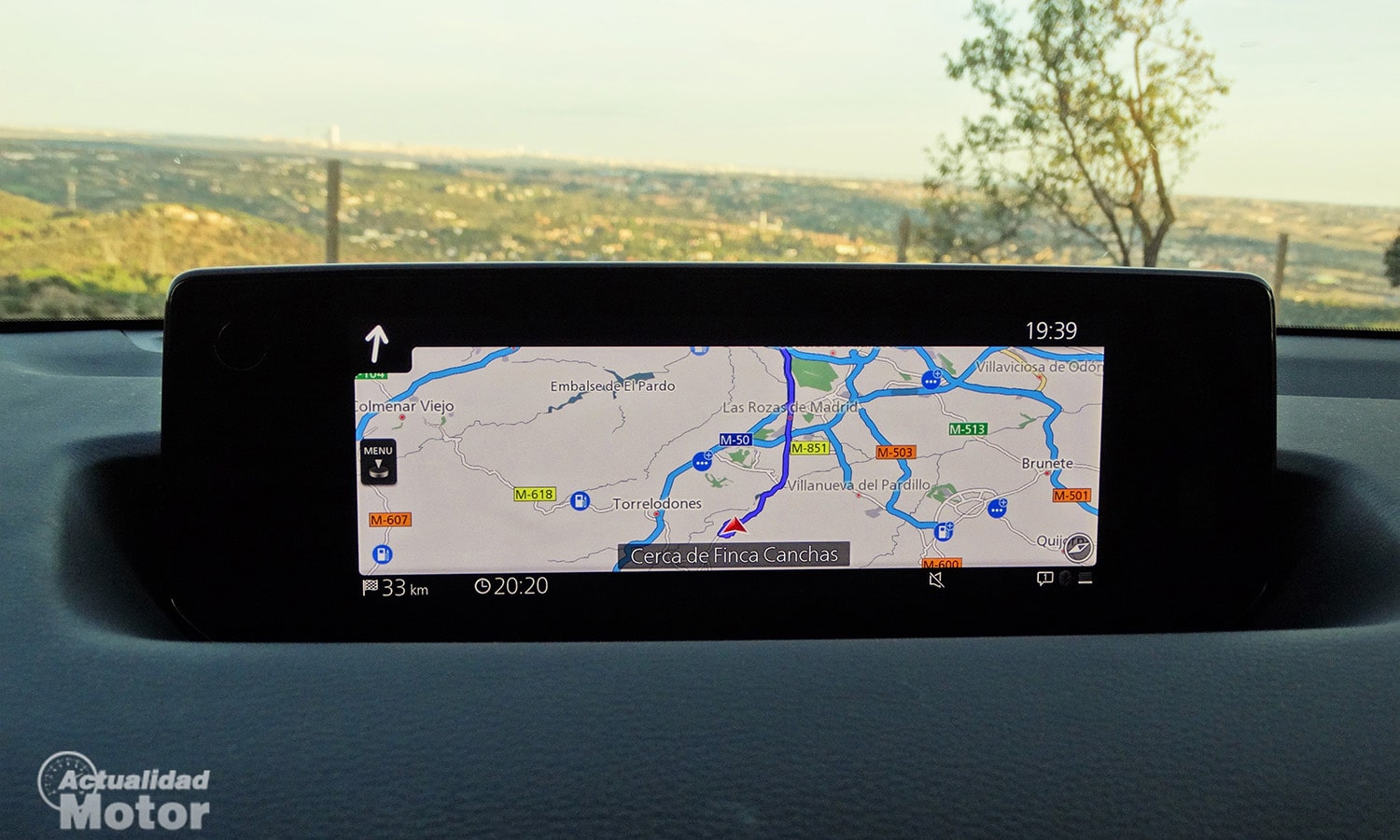
Origin
- Fabric upholstery
- 8,8-inch center screen
- Multifunction steering wheel
- 60/40 split folding rear seats
- Instrument panel with 7-inch screen
- Head-Up Display
- Climate control screen
- Cams for retention
- 18-inch wheels
- Black mirrors
- LED headlights and taillights with halogen daytime running lights
- Rear view camera
- Navigator
- Digital radio and 8 speakers
- Android Auto and Apple CarPlay
- e-GVC Plus
- Automatic emergency braking with pedestrian recognition
- blind spot monitoring
- Signal recognition
- Lane departure warning
- Adaptive cruise control
- Front and rear parking sensors
- automatic high beams
1st Edition (add to Origin)
- Modern or Vintage interior finishes
- Heated Seats
- Frameless anti-glare mirrors
- Steering wheel with chrome bezel
- Power driver's seat with memory
- Adaptive Full LED headlights
- 18-inch wheels
- darkened glasses
- Center armrest with 2 cup holders
Evolution (adds to Origin)
- Modern or Vintage interior finishes
- Heated Seats
- Frameless anti-glare mirrors
- Steering wheel with chrome bezel
- Power driver's seat with memory
- Head-Up Display
- heated steering wheel
- 150W power outlet
- Hands-free entry and start
- Interior cork handles
- Adaptive Full LED headlights
- 18-inch wheels
- darkened glasses
- Rear armrest with 2 cup holders
Zenith (adds to Evolution)
- Bose sound system with 12 speakers
- 360 degree camera
- Fatigue detector with camera
- Cruise control and traffic assistant
- Rear city braking
- front traffic sensor
Mazda MX-30 Prices
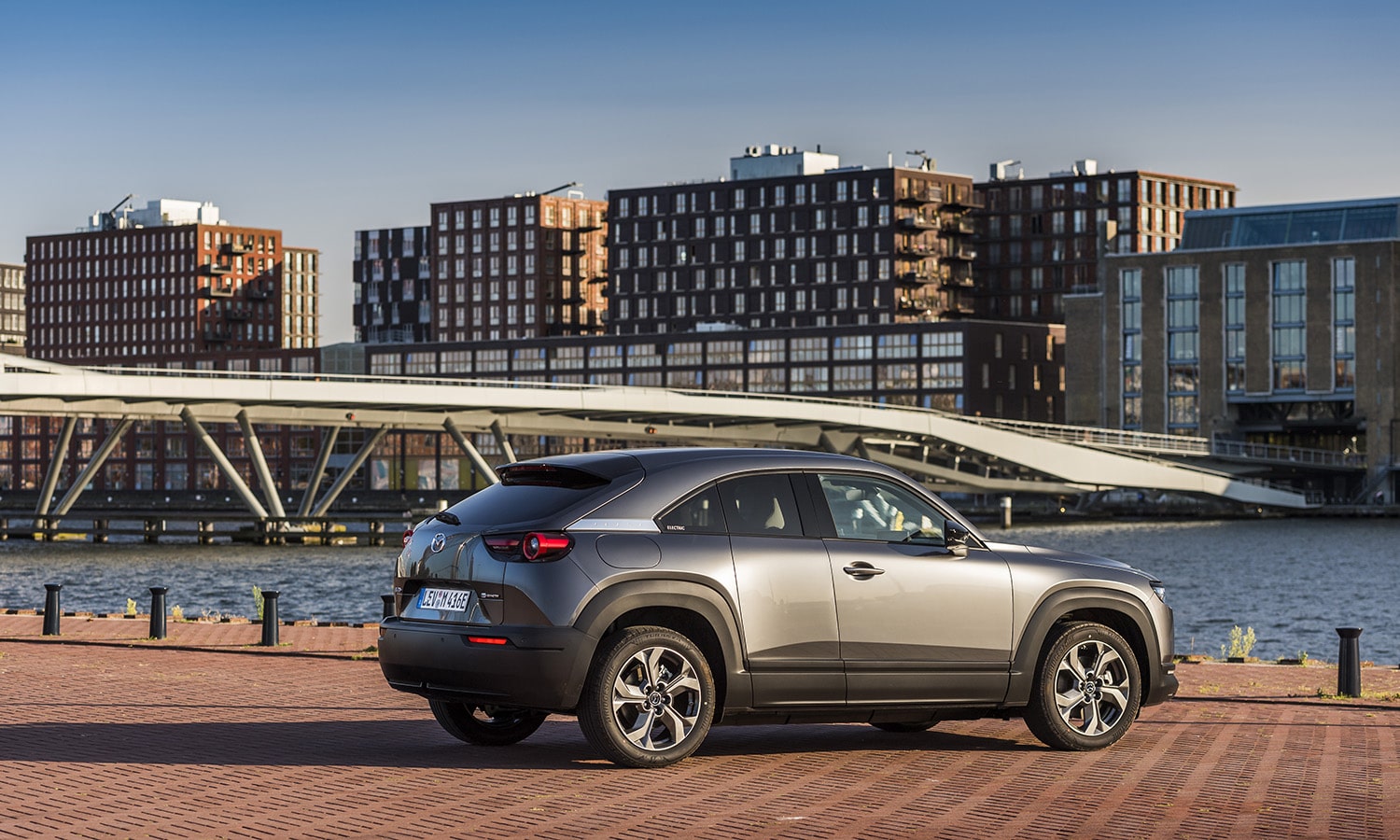
| Finish | Package | Price |
|---|---|---|
| Finish | Package | Price |
| Origin | - | 34.375 € |
| 1st Edition | Modern | 34.590 € |
| 1st Edition | Vintage | 34.590 € |
| Evolution | Modern | 36.850 € |
| Evolution | Vintage | 36.850 € |
| Zenith | Modern | 38.250 € |
| Zenith | Vintage | 38.250 € |
